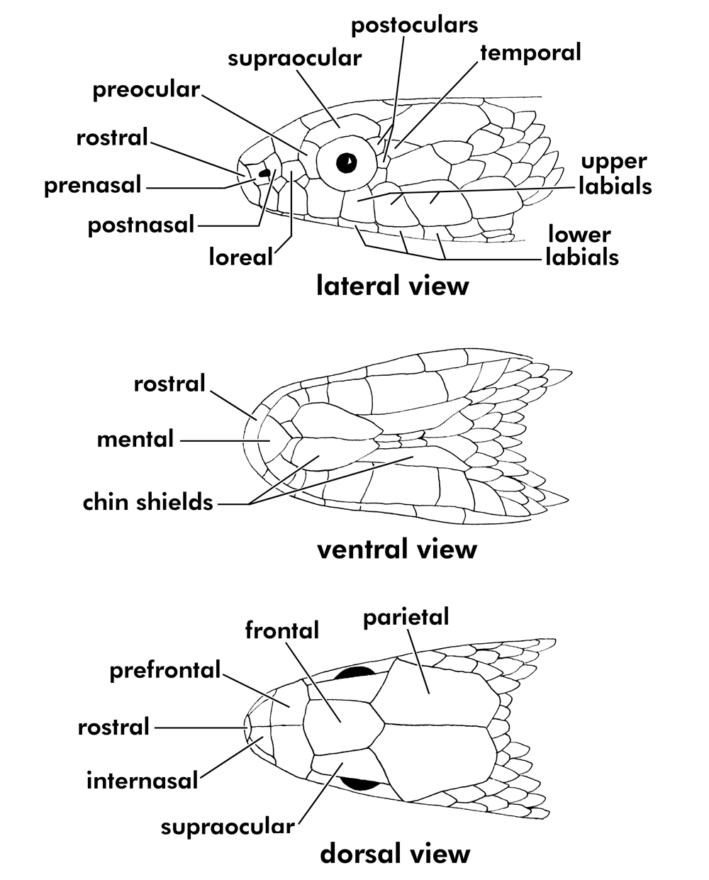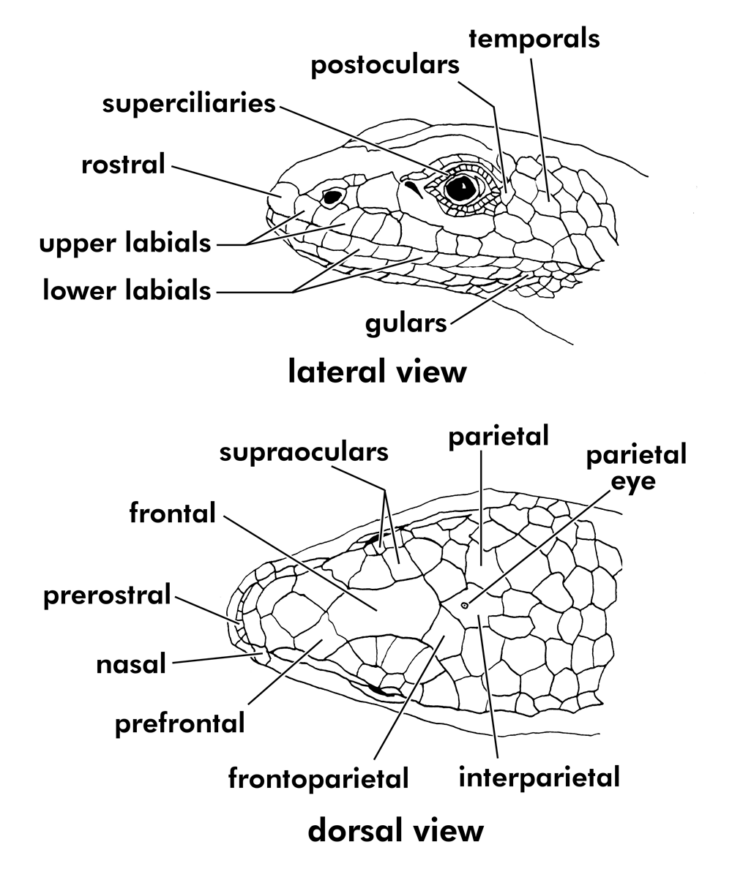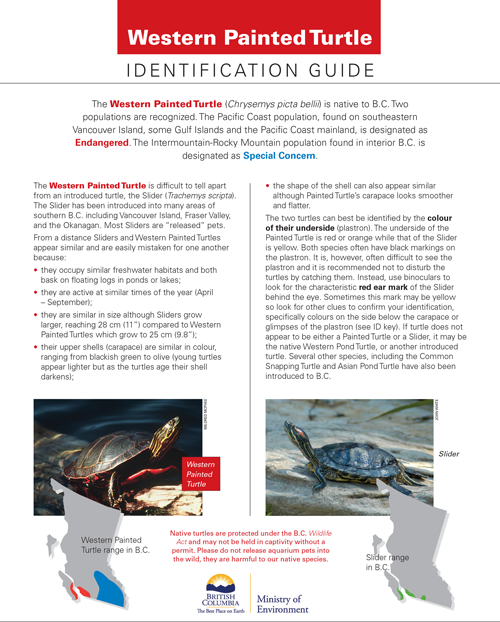Reptile Identification Keys
HOW TO USE
To start, read both options starting with number 1 (1a. and 1b.). Choose the option that is true for the species yo1a. Button or rattle on end of tail; body with a series of dark blotches down back, but sometimes dark overall; head large and triangular…………………Western Rattlesnake (Crotalus oreganus)
1b. No button or rattle on end of tail…………………2
2a. Series of blotches down back…………………3
2b. No blotches down back…………………5
3a. Dorsal blotches often paired, only somewhat larger than those on side; three distinct dark brown blotches on back of neck; pupil of eye vertically elliptical…………………Night Snake (Hypsiglena torquata)
3b. Dorsal blotches single and substantially larger than those on side…………………4
4a. Blotches dark brown against yellowish background…………………Gopher Snake (Pituophis catenifer)
4b. Blotches brownish against blue-grey background; small snake…………………Racer (Coluber constrictor)
5a. Dorsal colour uniform brown or grey-blue; skin usually fairly shiny (smooth scales)…………………6
5b. Dorsal colour not as in 5a…………………7
6a. Dorsal colour uniform brown; body short and stout with blunt head and tail; eye very small relative to head…………………Rubber Boa (Charina bottae)
6b. Dorsal colour uniform grey-blue; body long and slender; well-defined head and long, whip-like tail…………………Racer (Coluber constrictor)
7a. Longitudinal mid-dorsal stripe along back…………………8
7b. No stripe down back…………………9
8a. Mid-dorsal stripe straight sided and bright yellow; background black, often with red blotches on side of body…………………Common Garter Snake (Thamnophis sirtalis)
8b. Colouration different from 8a…………………10
9a. Dorsal surface brown with slight checkering, or uniform black, not shiny; possibly with red blotches on ventral surface…………………Northwestern Garter Snake (Thamnophis ordinoides)
9b. Dorsal colour greyish, yellow-brown, or reddish-brown, usually with yellowish or reddish stripe along each side; tail with sharp, pointed tip; small (<500 mm svl)…………………Sharp-tailed Snake (Contia tenuis)
10a. Dorsal background colour brown with yellowish mid-dorsal stripe (stripe often faint) or black with red mid-dorsal stripe (stripe often incomplete or broken); possibly with red blotches on ventral surface…………………Northwestern Garter Snake (Thamnophis ordinoides)
10b. Mid-dorsal stripe usually in zigzag form; often two rows of alternating dark blotches on sides of body; sometimes bluish all over…………………Western Terrestrial Garter Snake (Thamnophis elegans)u are trying to identify. At the end of the statement you selected to be true, there will be another number. That number is the next step in your identification journey. Read both options that start with that number, select the one that is true for your species, and repeat. Once you get to the final step, instead of a number at the end of the true statement, there will be the name of your species! If you don’t know what some of the terms mean, try using the glossary or the images included here to help you out.

Reference:
Matsuda BM, Green DM, Gregory PT. 2006. Amphibians and Reptiles of British Columbia. Victoria (BC): Royal BC Museum. 266 p.
HOW TO USE
To start, read both options starting with number 1 (1a. and 1b.). Choose the option that is true for the species you are trying to identify. At the end of the statement you selected to be true, there will be another number. That number is the next step in your identification journey. Read both options that start with that number, select the one that is true for your species, and repeat. Once you get to the final step, instead of a number at the end of the true statement, there will be the name of your species! If you don’t know what some of the terms mean, try using the glossary or the images included here to help you out.
1b. Some or all of body scales smooth…………………5
2a. Pit or cavity on side of head between nostril and eye; button or rattle on end of tail…………………Western Rattlesnake (Crotalus oreganus)
2b. No pit or rattle…………………3
3a. 17 rows of body scales at mid-body…………………Northwestern Garter Snake (Thamnophis ordinoides)
3b. More than 17 rows of body scales at mid-body…………………4
4a. 19 rows of body scales at mid-body…………………Common Garter Snake (Thamnophis sirtalis)
4b. 21 rows of body scales at mid-body…………………Western Terrestrial Garter Snake (Thamnophis elegans)
5a. Scutes on back slightly keeled, all other body scales smooth; series of dark brown blotches down back; dark line across head in front of eyes plus a dark band from eye to angle of jaw…………………Gopher Snake (Pituophis catenifer)
5b. All body scales smooth…………………6
6a. Head and tip of tail blunt; 44-45 rows of body scales at midbody; eye very small relative to head…………………Rubber Boa (Charina bottae)
6b. Fewer than 44 rows of body scales at mid-body…………………7
7a. 21 rows of body scales at mid-body; yellow-grey background with numerous brown blotches, the mid-dorsal row often occurring in pairs; 3 dark brown blotches on back of neck; pupil of eye vertically elliptical…………………Night Snake (Hypsiglena torquata)
7b. Fewer than 21 rows of body scales at mid-body…………………8
8a. 15 rows of body scales at mid-body; tail with sharp, pointed scute at tip; usually a yellowish or reddish stripe along each side; small (<500 mm svl)…………………Sharp-tailed Snake (Contia tenuis)
8b. 15-17 rows of body scales at mid-body; head large with large eyes, tail long and whip-like; dorsal colour grey-blue, although small specimens may have series of large blotches down back…………………Racer (Coluber constrictor)

Reference:
Matsuda BM, Green DM, Gregory PT. 2006. Amphibians and Reptiles of British Columbia. Victoria (BC): Royal BC Museum. 266 p.
HOW TO USE
1a. Body short, squat, and flattened, with a short tail (much shorter than length of body); spiny scutes on body and back of head…………………Pigmy Short-horned Lizard (Phrynosoma douglasii)
1b. Body long and slender with pointed snout and long tail (longer than body when intact); no spines on body…………………2
2a. Colour dull brown with dark blotches (small specimens may be copper coloured); prominent fold of skin along lower side of body (scutes in area of fold smaller than those on back; noticeable when sides expanded); large scales on back and belly separated by smaller mid-lateral scales…………………Northern Alligator Lizard (Elgaria coerulea)
2b. Body marked with prominent stripes and/or dark spots or reticulations…………………3
3a. Alternating, longitudinal stripes of brown and white along dorsal surface; small specimens may have blue tails; shiny appearance; scales around abdomen nearly equal in size…………………Western Skink (Eumeces skiltonianus)
3b. Prominent black markings on body, including longitudinal stripes; not shiny; scales on belly large, but bead-like on back and sides…………………Wall Lizard (Podarcis muralis)

Reference:
Matsuda BM, Green DM, Gregory PT. 2006. Amphibians and Reptiles of British Columbia. Victoria (BC): Royal BC Museum. 266 p.
HOW TO USE
1a. Forelimbs in the form of elongate flippers with one claw at most; in marine habitat; may be up to 1 or 2 metres in length; head and limbs not retractile…………………2
1b. Forelimbs with claws; almost always in freshwater habitat; shell never more than 25 cm long; head and limbs retractile…………………3
2a. Leathery shell and skin with no scutes; no claws on forelimbs; prominent longitudinal ridges on the carapace…………………Leatherback Turtle (Dermochelys coriacea)
2b. Carapace with laminae; large scutes on head and tail; one claw on each forelimb…………………Green Turtle (Chelonia mydas)
3a. Coloration dull brown or blackish, with irregular black or brown markings…………………Western Pond Turtle (Actinemys marmorata)
3b. Carapace black or olive brown; plastron bright red with large black blotch in centre; head and limbs black or olive with bright yellow markings…………………Painted Turtle (Chrysemys picta)



